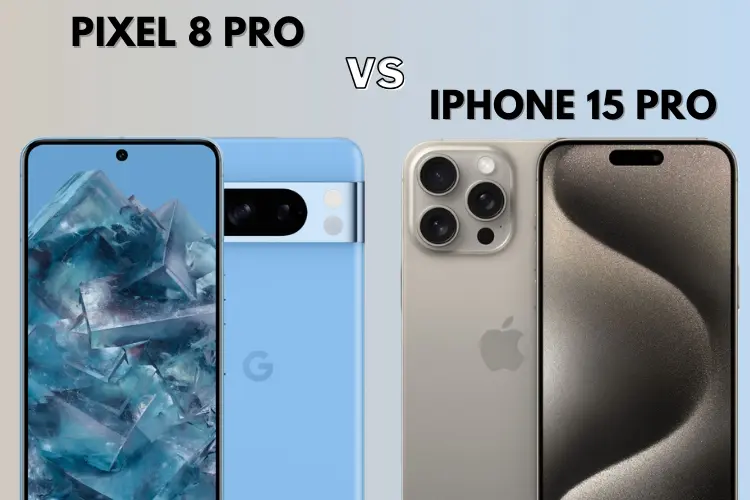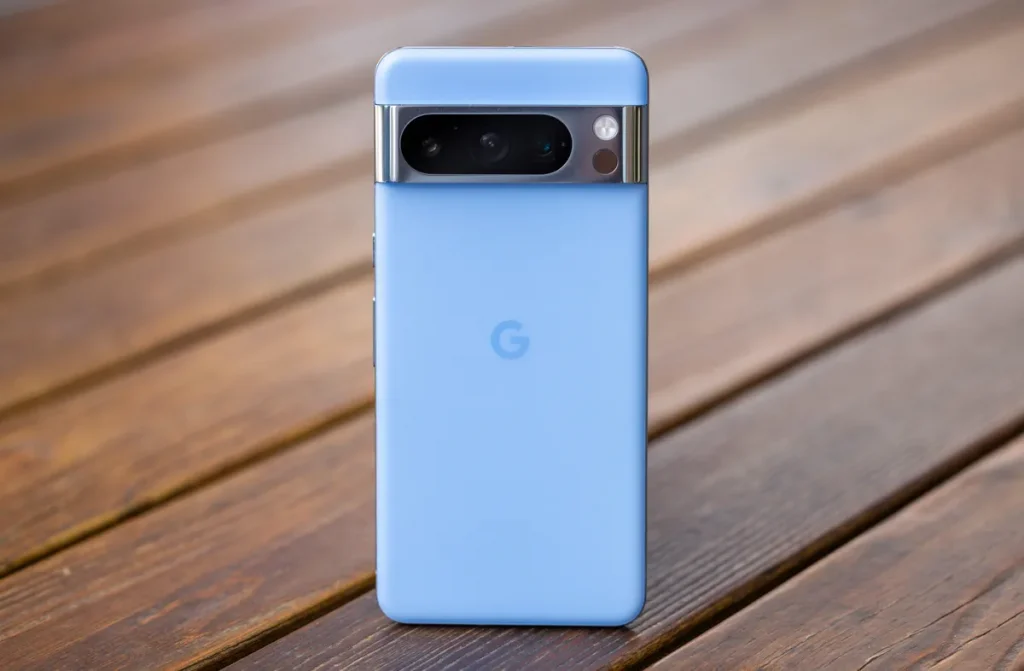Smartphone camera technology has indeed made significant strides, becoming a crucial factor when selecting a new phone. The launch of the Google Pixel 8 Pro and the iPhone 15 Pro Max has added a new layer of complexity to the decision-making process for photography enthusiasts. In this comprehensive camera comparison, we will thoroughly examine the strengths and weaknesses of the camera systems on both of these devices, aiding you in your quest for the “Best smartphone camera: Pixel 8 Pro vs iPhone 15 Pro Max.
Table of Contents
Primary Cameras. Best Smartphone Camera: Pixel 8 Pro vs iPhone 15 Pro Max

Both the Pixel 8 Pro and iPhone 15 Pro Max boast exceptional primary cameras with high detail and dynamic range. However, they have distinct characteristics that set them apart in the realm of smartphone photography. In this comprehensive comparison, we’ll delve into the strengths and weaknesses of both devices’ camera systems, helping you make an informed decision when choosing between the Pixel 8 Pro and iPhone 15 Pro Max for your photography needs. “Best Smartphone Camera: Pixel 8 Pro vs iPhone 15 Pro Max”
Pixel’s Signature Look

The Pixel camera is known for its signature look – punchy and contrast-rich images. It captures scenes with vibrant colors and striking contrast. In contrast, the iPhone opts for a flatter image, offering a canvas for post-processing and editing. This flexibility is ideal for those who like to fine-tune their photos.
Dynamic Range
One area where the Pixel excels is dynamic range. It retains shadow detail exceptionally well, even in challenging lighting conditions. The iPhone’s dynamic range is also impressive, but the Pixel’s ability to maintain shadow detail stands out.
Resolution
The iPhone, under good conditions, shoots at 24 megapixels by default, offering more detail and the ability to crop images further. The Pixel, despite its slightly lower resolution, delivers sharp results, largely due to its sophisticated image processing.
Ultra High Resolution
Both phones can shoot at the maximum resolution, with the Pixel offering 50 megapixels and the iPhone offering 48. At 100%, the Pixel’s images appear sharper, which is attributed to its image processing capabilities. High-resolution tests confirm the Pixel’s better performance in maintaining image details.
Low-Light Photography
Low-light photography is a crucial aspect of smartphone cameras, and both the Pixel 8 Pro and iPhone 15 Pro Max perform admirably.
Pixel’s Low-Light Prowess
In most low-light scenarios, the Pixel shines. It excels in maintaining sharpness and capturing more light, resulting in brighter and clearer images. The iPhone also performs well in low light, but it tends to struggle in situations where the Pixel still delivers excellent results.
Night Mode

Both phones offer a night mode that takes a few seconds to capture multiple shots and combine them for optimal results. In specific cases, such as preserving highlight details and sharpness, the iPhone prevails.
Ultra-Wide Photography
The ultra-wide cameras on both devices are excellent in terms of detail and dynamic range. The Pixel’s ultra-wide camera is slightly wider and delivers better dynamic range, as evidenced by its ability to preserve highlight and shadow details.
Macro Photography
Both phones perform admirably in macro photography, capturing intricate details up close. While the iPhone allows you to get a bit closer, the Pixel’s results are still impressive in this category.
Zoom Capabilities
Zoom is an essential aspect of modern smartphone cameras, and both devices provide a range of options.
Optical Zoom
Both phones offer 1x and 2x optical zoom, using the middle part of the sensor to provide lossless zoom. The competition gets fierce when it comes to 5x zoom, where the optical zoom capabilities of both devices kick in. After rigorous testing, the iPhone demonstrates a slight edge in capturing more detail, particularly at higher zoom levels.
Low-Light Zoom
In low-light scenarios, the iPhone outperforms the Pixel in zoom photography. The iPhone’s ability to capture more light with its telephoto camera and maintain better detail makes it the preferred choice in low-light zoom situations.
Extended Zoom
Even in extreme zoom scenarios, the iPhone consistently delivers sharper results. The Pixel sometimes struggles to focus at extended zoom ranges, giving the iPhone a clear advantage.
Portrait Photography
Portrait mode is a feature many users adore, and both phones have their strengths.
Pixel’s Portrait Modes
The Pixel provides portrait modes at 1.5x or 2x, while the iPhone offers 1x, 2x, and 5x portrait options. When compared, the iPhone typically outperforms the Pixel in edge detection and hair details, making it a better choice for portrait enthusiasts.
Portrait Mode in Low Light
In low-light portrait scenarios, the iPhone continues to impress with its edge detection and overall quality. The Pixel, while still producing commendable results, sometimes struggles with gray hair and other intricate details.
Selfie Cameras

Selfies are an integral part of modern smartphone photography, and both phones deliver remarkable results.
Pixel’s Real Tone
The Pixel excels at maintaining accurate skin tones, thanks to its Real Tone technology. It strives to depict users’ skin colors realistically. However, in some scenarios, the iPhone’s dynamic range shines through, maintaining details in complex situations.
iPhone’s Pleasing Selfies
The iPhone tends to provide more aesthetically pleasing selfies, even in challenging scenarios. While the Pixel aims for realism, the iPhone delivers a more flattering look. The choice between the two depends on personal preferences.
Video Quality
Video quality is another critical factor, and both phones offer excellent video capabilities.
iPhone’s Video Excellence
The iPhone shines with its video quality, maintaining details in both highlights and shadows. Its dynamic range is a standout feature, even in challenging conditions. It also offers ProRes with Log, a flat picture profile for professional filmmakers.
Pixel’s Video Improvements
The Pixel’s video quality has improved over previous models, but it still falls slightly short of the iPhone, especially in dynamic range. Google is set to introduce Video Boost, a feature that should further enhance video quality, but it’s not available at the time of this comparison.
Slow Motion
Both phones offer slow-motion capabilities, and the difference in quality is minimal. Slow-motion performance hasn’t changed significantly in recent years.
Front-Facing Camera
The front-facing cameras on both phones deliver impressive results. The iPhone maintains better dynamic range, but the Pixel provides more accurate skin tones.
Stabilization
Both phones offer stable video recording at 4K, but the iPhone takes it a step further by enabling action mode at higher resolutions. The stabilization modes on both devices are remarkably effective, guaranteeing smooth video footage. This integration of “Best smartphone camera: Pixel 8 Pro vs iPhone 15 Pro Max”
Audio Quality
Audio quality is another crucial consideration when comparing the Best smartphone camera: Pixel 8 Pro vs iPhone 15 Pro Max. The Pixel’s Speech Enhancement technology ensures cleaner audio by reducing background noise. What’s more, it offers the innovative Audio Magic Eraser feature, allowing users to eliminate background noises, even from older videos. In contrast, the iPhone’s Voice Isolation feature is effective for calls but, at present, is not available for video recording.
Conclusion
Both the Google Pixel 8 Pro and the iPhone 15 Pro Max present exceptional camera systems, each with its distinct strengths. The Pixel stands out for its impressive dynamic range, true-to-life skin tones, and innovative software features. On the other hand, the iPhone offers consistent performance, superior portrait photography, exceptional low-light capabilities, and remarkable video quality.
Ultimately, the choice between these two devices hinges on personal preferences and priorities. Whether your focus leans towards dynamic range, lifelike skin tones, and feature-rich software (Pixel), or you prioritize consistency, top-tier low-light photography, and outstanding video performance (iPhone), both smartphones cater to the needs and desires of photography enthusiasts.
1. Which phone is better for low-light photography?
In the realm of low-light photography, both the Pixel 8 Pro and the iPhone 15 Pro Max exhibit impressive performance. The Pixel 8 Pro, however, stands out with its exceptional ability to maintain shadow detail and produce brighter images. Nonetheless, the iPhone 15 Pro Max remains a strong contender in low-light scenarios, particularly in its prowess at managing noise. This seamless incorporation of “Best smartphone camera: Pixel 8 Pro vs iPhone 15 Pro Max”
2. What are the standout features of the Pixel’s camera system?
The Pixel’s camera system is known for its signature look, exceptional dynamic range, and innovative software features like Audio Magic Eraser, Magic Editor, and Best Take. These features set it apart in terms of creativity and flexibility.
3. Does the iPhone’s ProRes with Log offer significant advantages for video recording?
Yes, the ProRes with Log feature on the iPhone is a valuable tool for professional filmmakers. It provides a flat picture profile that’s ideal for post-processing and color grading, allowing for greater creative control over video production.
4. Which phone is better for portrait photography?
In the realm of portrait photography, the iPhone often takes the lead over the Pixel, showcasing superior edge detection and more intricate results, particularly in challenging situations. Nevertheless, the decision between these two options may hinge on individual preferences. The incorporation of “Best Smartphone Camera: Pixel 8 Pro vs iPhone 15 Pro Max
5. Which phone offers more flexibility for zoom photography?
The iPhone provides more versatility for zoom photography, offering optical zoom options at various focal lengths, including a 2.7K action mode. This versatility empowers users to effortlessly capture distant subjects.
In conclusion, both the Google Pixel 8 Pro and the iPhone 15 Pro Max boast exceptional camera systems. The Pixel emphasizes creativity and software innovation, while the iPhone consistently delivers impressive performance across various photography and videography scenarios. Your choice should align with your specific photography priorities and preferences. “Best smartphone camera: Pixel 8 Pro vs iPhone 15 Pro Max”
Best Smartphone Camera: Pixel 8 Pro vs iPhone 15 Pro Max
Frequently Asked Questions
Best Smartphone Camera: Pixel 8 Pro vs iPhone 15 Pro Max
Both phones perform well in low-light photography, but the Pixel 8 Pro tends to excel in maintaining shadow detail and delivering brighter images. However, the iPhone 15 Pro Max is still a strong contender in low-light scenarios, particularly when it comes to managing noise.
2. What are the standout features of the Pixel’s camera system?
The Pixel’s camera system is known for its signature look, exceptional dynamic range, and innovative software features like Audio Magic Eraser, Magic Editor, and Best Take. These features set it apart in terms of creativity and flexibility.
3. Does the iPhone’s ProRes with Log offer significant advantages for video recording?
Yes, the ProRes with Log feature on the iPhone is a valuable tool for professional filmmakers. It provides a flat picture profile that’s ideal for post-processing and color grading, allowing for greater creative control over video production.
4. Which phone is better for portrait photography?
When it comes to portrait photography, the iPhone generally outperforms the Pixel, offering better edge detection and more detailed results, especially in complex scenarios. However, the choice between the two may depend on personal preferences.
5. Which phone offers more flexibility for zoom photography?
The iPhone offers more versatility for zoom photography, providing optical zoom options at various focal lengths, including 2.7K action mode. This flexibility allows users to capture distant subjects with ease.
In conclusion, both the Google Pixel 8 Pro and the iPhone 15 Pro Max offer remarkable camera systems. The Pixel focuses on creativity and software innovation, while the iPhone delivers consistent and impressive performance in various photography and videography scenarios. Your choice should align with your specific photography priorities and preferences. When comparing the “Best smartphone camera: Pixel 8 Pro vs iPhone 15 Pro Max,